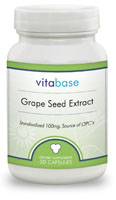| |
Grape seed extract |
|
| Grape seed extract is derived from the small seeds of grapes. Grape is a family of mostly climbing shrubs, widespread in tropical and subtropical regions and extending into the temperate zones. Grapes are native to Asia near the Caspian Sea, but were brought to North America and Europe around the 1600's. This plant's climbing vine has large, jagged leaves, and its stem bark tends to peel. The grapes may be green, red, or purple. Grape seeds are rich in chemicals called proanthocyanidins that exhibit antioxidant properties. Grape seed extract is the primary commercial source of a group of powerful antioxidants known as oligomeric proanthocyanidins (OPCs), also generically called pycnogenol, a class of flavonoids. Commercial preparations of grape seed extract are usually standardized on the basis of their proanthocyanidin content. |
| |
Grape seed proanthocyanidins |
|
| The active ingredients of grape seed include procyanidins (also known as condensed tannins, pycnogenols, and oligomeric proanthocyanidins or OPCs), flavonoids, linoleic acid, and vitamin E. Grape seeds contain a high content of oligomeric proanthocyanidins (OPCs). Grape seed proanthocyanidins are mainly comprised of dimers, trimers and tetramers of catechin and epicatechin and their gallates. The OPCs are chemically known as flavonoids or polyphenols. Oligomeric proanthocyanidins act as antioxidants (free radical scavengers) in the human body. OPCs are much more effective than vitamin C and vitamin E in neutralizing free oxygen radicals. OPCs may help protect against the effects of internal and environmental stresses (such as cigarette smoking, pollution, and supporting normal body metabolic processes). Proanthocyanidin also strengthens the tiny blood vessels called capillaries, preventing leakage and reducing swelling in nearby tissues. |
| |
Medicinal uses and health benefits of grape seed extract |
|
| Grape seed extract is famous for its strong antioxidant ability to neutralize free radicals and may help treat or prevent a range of
health problems related to free radical damage, including heart disease and cancer. The antioxidants in grape seed extract neutralize mutations within the genetic material of cells that could lead to tumor formation. Thus it is useful to prevent the development and progression of cancers of the lung, breast, stomach, prostate, colon, skin and other body parts may be stalled as a result. Antioxidants in grape seed extract may help prevent damage to blood vessels and other changes that may contribute to the development of heart disease. Grape seed extract may help to prevent and treat heart diseases such as high blood pressure and high cholesterol. Grape seed extract reduces capillary permeability and fragility and may be used for the treatment and prevention of vascular or circulatory disorders such as venous insufficiency, peripheral vascular disease, and varicose veins. The antioxidant effect of grape seed serves to reduce the buildup of the bad cholesterol that clogs the arteries and leads to stroke and heart attacks. Grape seed extract may be useful in treating inflammatory skin conditions such as psoriasis. The flavonoids in grape seed also inhibit allergic reactions that can generate such skin problems as eczema. The antioxidant power of grape seed extract can help by protecting besieged muscle cells from damage which may lead to fibromyalgia. Grape seed extract is effective in preventing damage to human liver cells caused by chemotherapy medications. Pycnogenol in g rape seed helps inhibit the production of histamines, which decreases sensitivity to pollens and food allergens, thereby reducing allergic reactions. Grape seed extract improves blood flow in the eye's tiny vessels, where certain eye diseases can cause blockages and impairments that result in vision damage. Grape seed had been used for its liver protective effects, to improve circulation, and to improve skin tone and elasticity. Grape seed extract has been found to be beneficial in treating several respiratory conditions, including asthma, emphysema, allergies, and sinusitis. |
|
|
|
|
 Grape seed extract has shown that it has many powerful benefits. In mice, grape seed extract has been shown to lower blood pressure and improve cardiovascular function. It also encourages the growth of healthy cells. In addition it helps protect the body against kidney and liver disease. Vitabase's grape seed extract features LeucoSelect, a premium quality grape seed extract. Click here for more information.
Grape seed extract has shown that it has many powerful benefits. In mice, grape seed extract has been shown to lower blood pressure and improve cardiovascular function. It also encourages the growth of healthy cells. In addition it helps protect the body against kidney and liver disease. Vitabase's grape seed extract features LeucoSelect, a premium quality grape seed extract. Click here for more information.